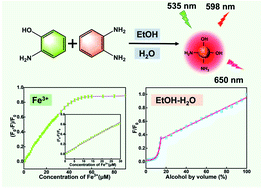Dual-emission carbon dots for sensitive fluorescence detection of metal ions and ethanol in water†
Abstract
Carbon dots (CDs) have been widely used in biomedical fields because of their superior optical properties, high sensitivity and high selectivity to specific substances. However, there are few studies on trace detection of the ethanol content in aqueous solution using CDs. Herein, novel red fluorescent CDs with dual emission are synthesized and show good dispersibility in various solvents and excitation independence of photoluminescence (PL). After investigating the structure and properties of the red CDs, a multifunctional fluorescent nanoprobe based on the red CDs with high-sensitivity detection for dual-ion trace detection of Fe3+ and Cu2+ can be successfully constructed. The limit of detection of Fe3+ and Cu2+ can be up to 0.024 μM and 0.036 μM, respectively, which is superior to that in previous reports. Meanwhile, in view of the specific solvent effect on their PL, the red CDs are able to be applied for trace detection of the ethanol content in aqueous solution. The methods of colorimetry and fluorescence spectrometry are utilized to perform the threshold test and high-sensitivity quantitative analysis of the ethanol content in aqueous solution. Based on this, a multifunctional fluorescent nanoprobe based on the dual-emission red CDs can be obtained, which provides a promising way for their applications in detection and sensing fields.



 Please wait while we load your content...
Please wait while we load your content...